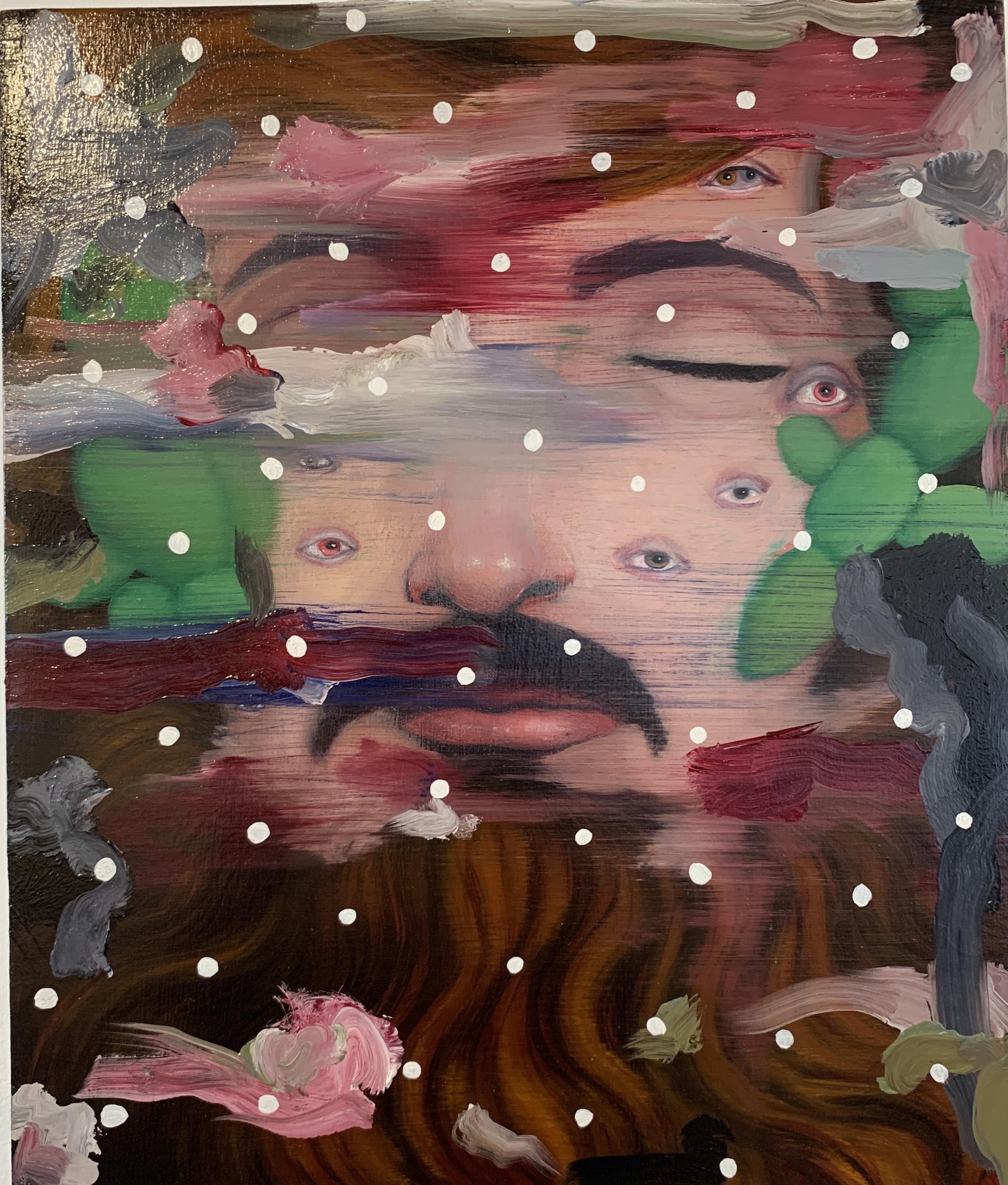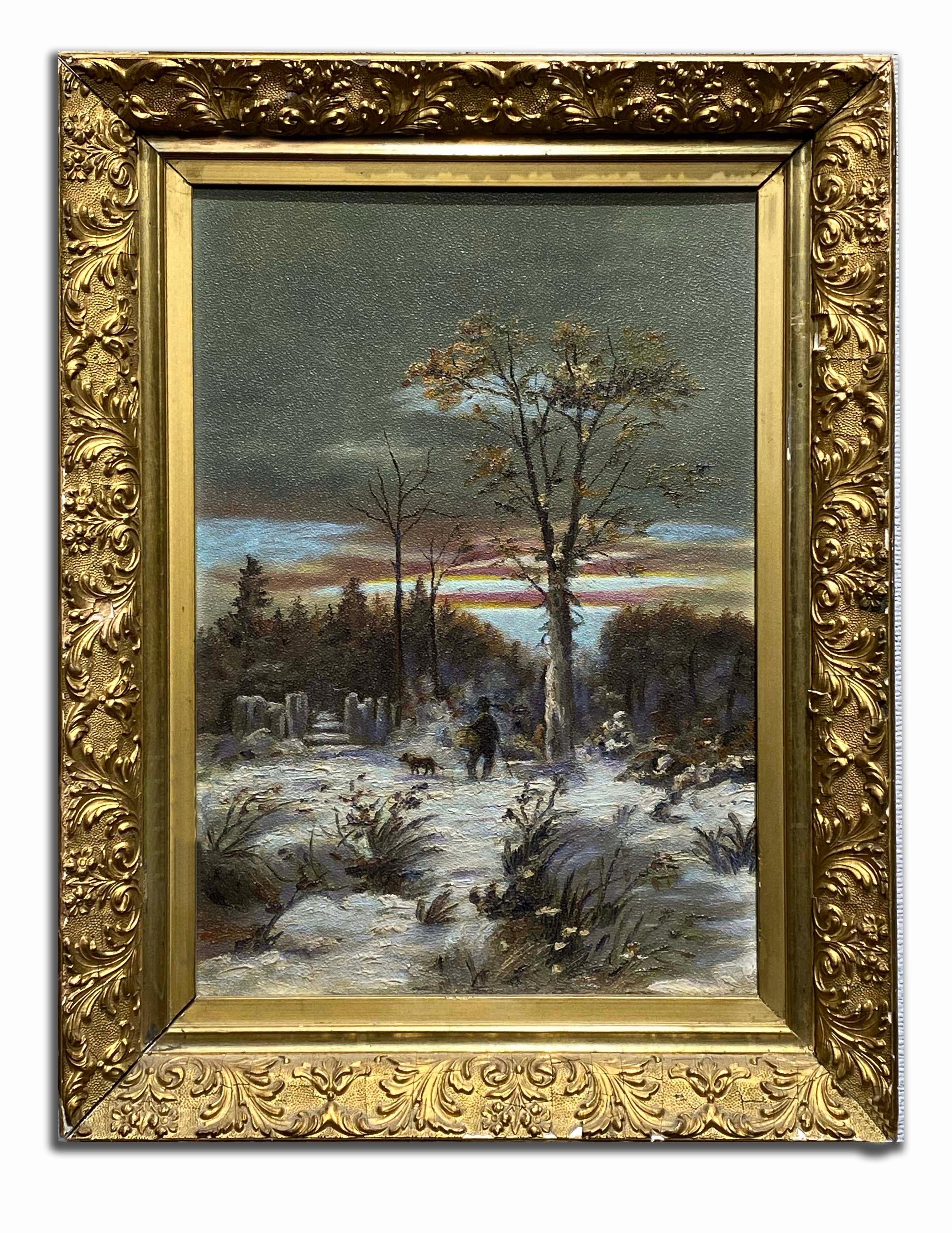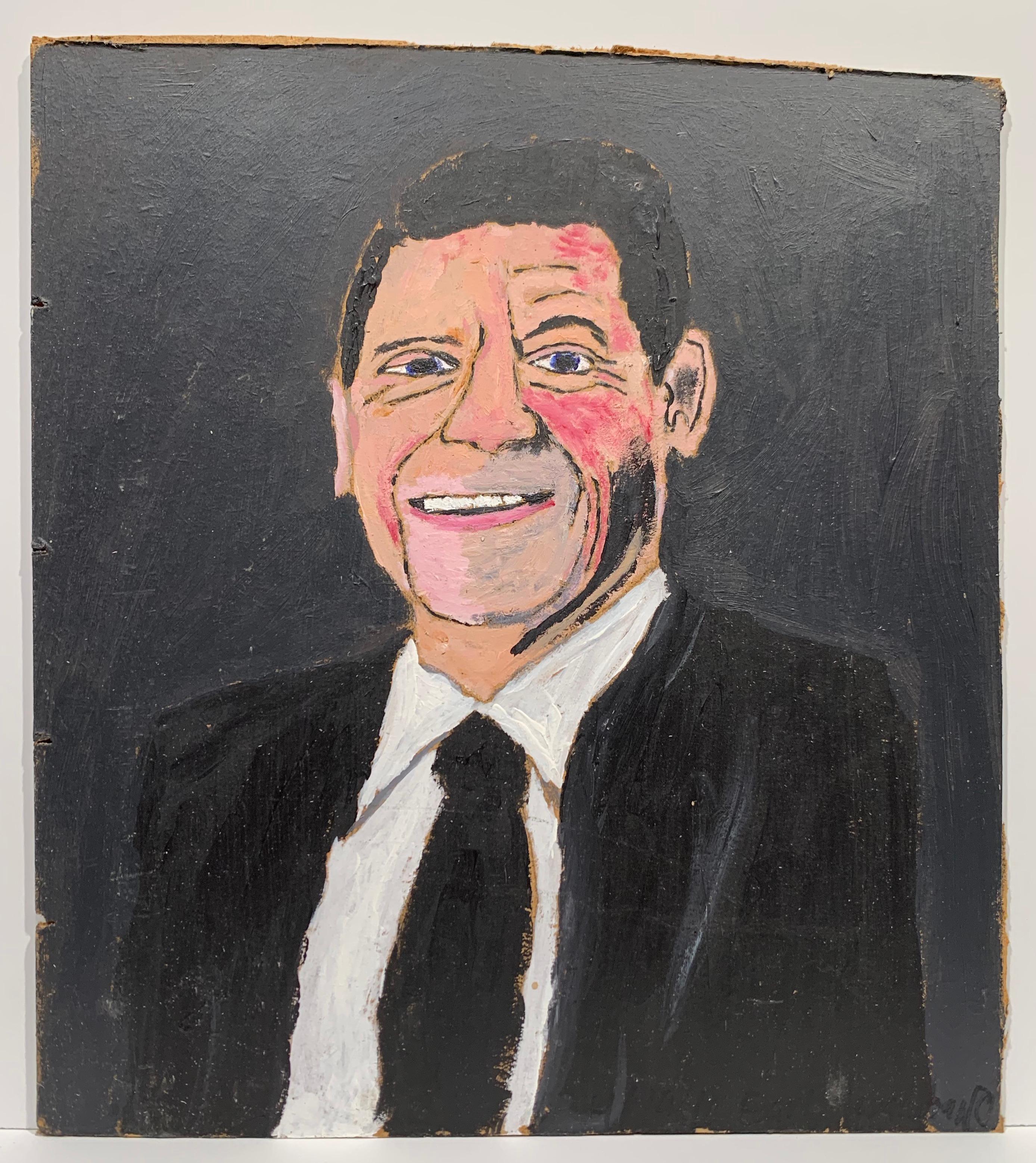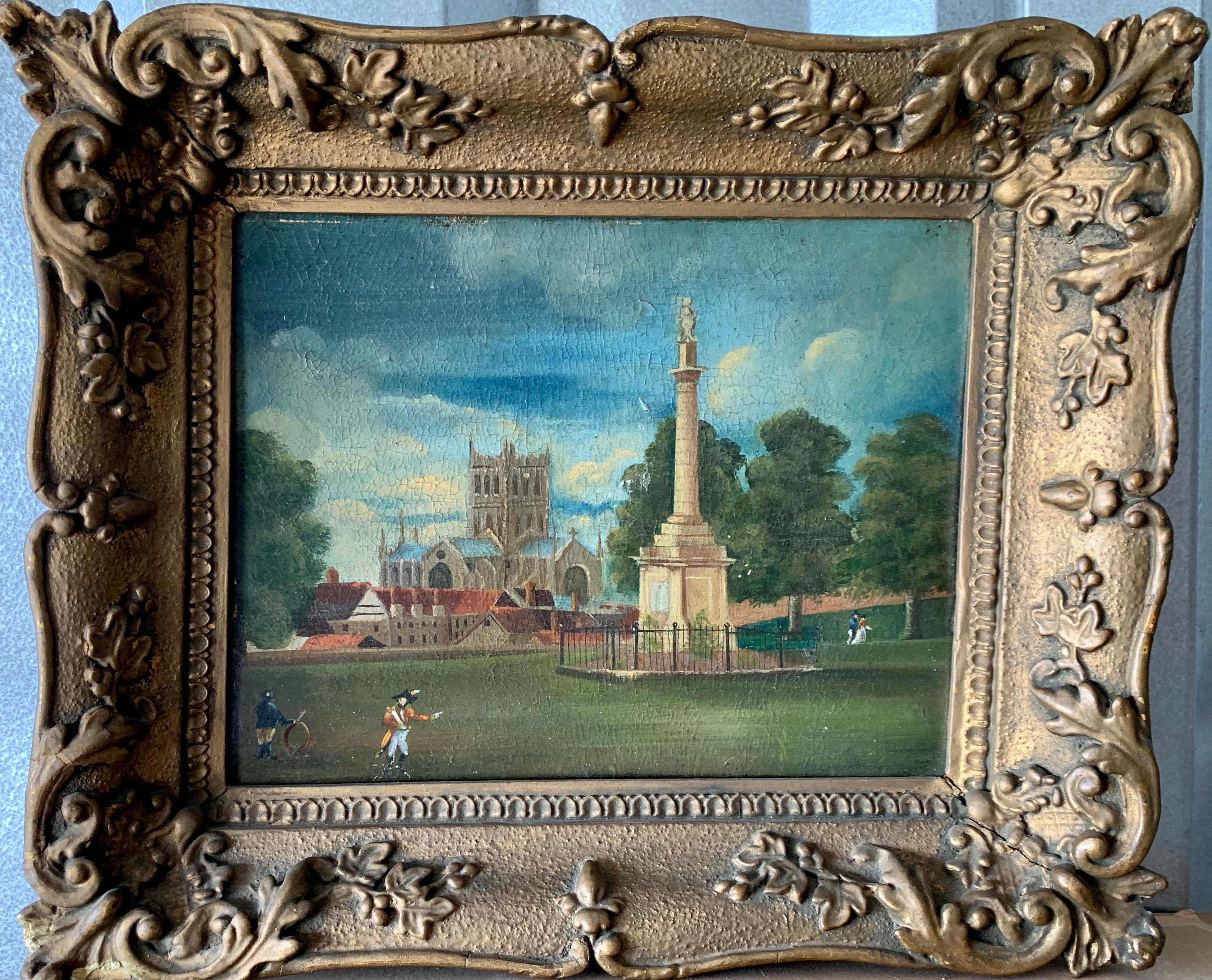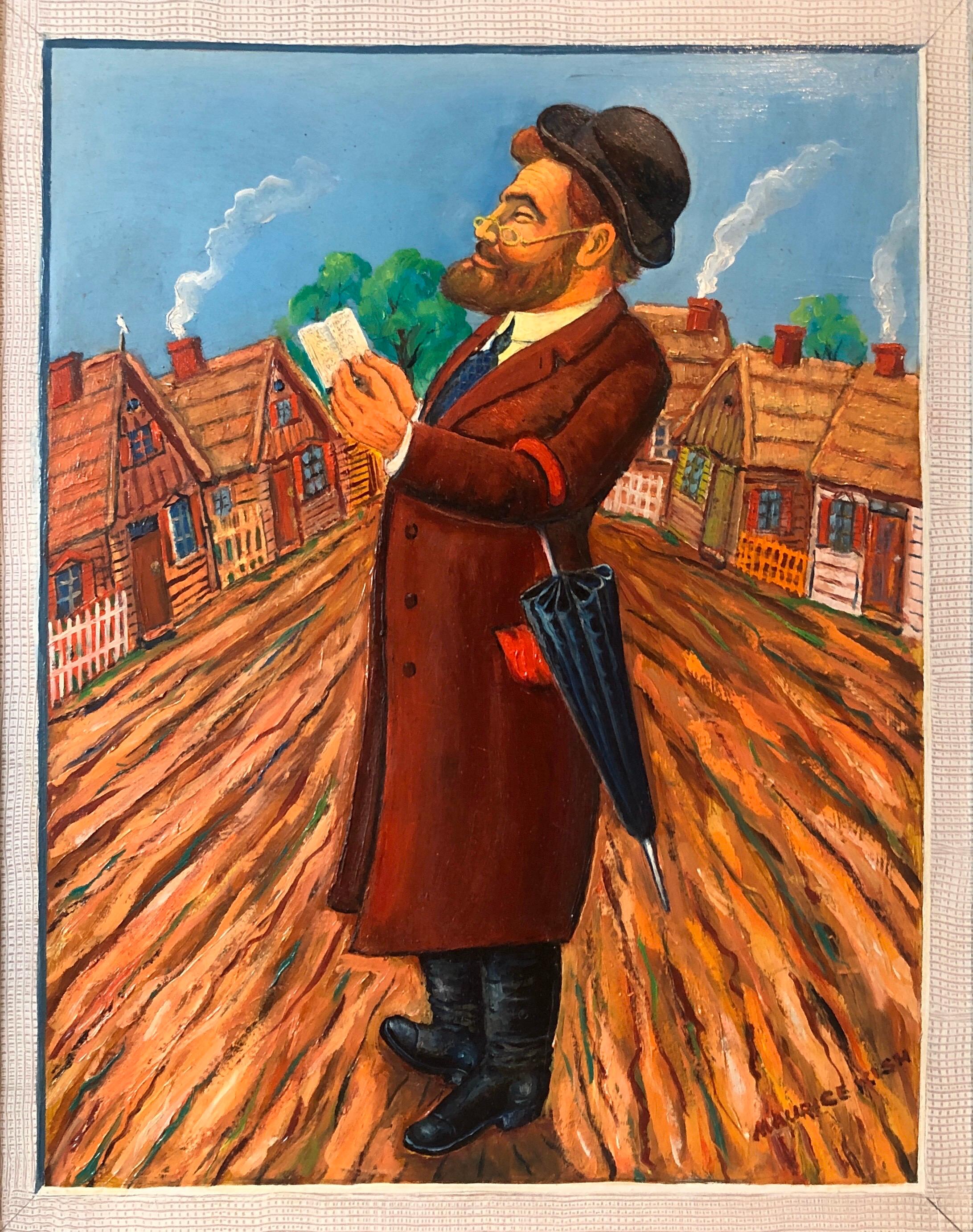Items Similar to The Happy Inlaw, Oil Painting
Want more images or videos?
Request additional images or videos from the seller
1 of 8
Maurice KishThe Happy Inlaw, Oil Painting1975
1975
About the Item
The imagery of Maurice Kish (1895-1987), whether factories or carousels, reliably subverts expectations. His vision hovers just around the unraveling edge of things, where what is solid and clear becomes ambiguous. He is fascinated, often delighted, by the falling apart. This unexpected, fresh perspective results in oddly affecting pictures of a now long-gone New York.
Born Moishe in a town called Dvinsk, Russia (what is now Daugavpils, Latvia), Kish came with his family to New York when he was in his teens. The family settled in Brownsville, and for the rest of Kish’s life Brooklyn remained his home, though he moved from one neighborhood to another. He was close to his parents, who recognized his talent and supported his desire to become an artist.
Kish attended the National Academy of Design as well as Cooper Union. His fellow students included many other immigrants and children of immigrants who were particularly receptive to the Modernism coming from Europe. As his career progressed, Kish himself applied different strains of Modernism to different purposes. For him, the story was held above all else.
For years, Kish used the skills he acquired in art school to earn his living at a Manhattan glass factory where he painted floral designs on vases. During the Depression, Kish became a WPA painter in the Federal Art Project (FAP). FAP artists were given a mandate to create works that celebrated labor. The artists tended to be socially progressive, as Kish certainly was. Kish's work from this period, with its dark colors and rolling clouds, reveals the influence of Social Realists like Thomas Hart Benton. Apparent, too, is Kish's interest in the urban monumentality of Charles Sheeler. Kish's structures, however, lack Sheeler's almost dehumanized precision. Rather than the soulless, sleek machines of a typical modern urban dystopia, Kish's factories are shaggy old beasts as worn out as the laborers who troop through their doors. In End of Day's Toil, now at the Smithsonian, the viewer feels some affection for that rambly grandfather of a building all the tired small workers are leaving behind.
Much of Kish's work, for the FAP and elsewhere, undermines received truths in a similar way. Some early works with themes from Yiddish culture are overtly humorous: a painting of a big jolly wedding guest, looking invitingly over her shoulder; a big fiddler on a small roof. Later, the humor becomes more ironic and reflective. In another work, the rather imposing organ grinder of the late 1930s looms above a child, yet his intermediary the cockatoo is bright and appealing, and offers the girl a fortune with his beak. This could read as an allegory for capitalism as easily as a straightforward colorful street scene. A small painting of a snowy day in Washington Square gives a bird's eye view of people bent against the wind walking alone or in pairs. The huge triumphal arch at the middle of it has no connection to their movements or their lives. Kish makes its size and centrality a quiet joke about the futility of grandiose gestures. Like the buildings in his FAP works, the arch has a personality. It is a landmark that looks a bit lost.
A favorite location for Kish was Coney Island. For the laborers of the city, this was a place of great freedom and possibility. There were no bosses! Anyone could go to ride the rides and swim in the sea. For Kish, Coney Island, and especially Luna Park, became a place richly symbolic of workers’ rights. For the dreamlike paintings he set there, Kish looked past the Social Realists to the Expressionists. His colors are brilliant and his lines are wild. These images, joyfully unrestrained, give full voice to an anarchic vision merely hinted at in other works. If the structures of the earlier pictures came further out of the background than expected, these Coney Island structures completely take over the scene.
Kish made several variations on the theme of the carousel as a site of revolution. In the moonlight, the horses have broken from their poles and spin away from the calm center. The workers have come to manic life, have released themselves from the yoke of labor and have abandoned their master, the merry-go-round. They escape to different corners of the pleasure park, dance together and ride the ferris wheel. One horse pretends to be a ticket seller. It is another allegory, one that depicts a worker's holiday paradise in carnival fashion.
A painter who embraced ambiguity, Kish was himself a man who occupied many worlds simultaneously. Even during the period when he had shows at prestigious galleries and belonged to several artists' groups, he identified most strongly as an outsider, a Yiddischer. He wrote poetry in Yiddish throughout his life. In 1968, he published a volume of fifty years of these poems, Di Velt ist Mayn Lid (The World is My Song) in Yiddish, with no English translation, for his peers. Kish also translated English-language poetry into Yiddish and acted as a guide to help other Yiddish writers. Long after the art organizations ceased to provide meaning and fulfillment, Kish was a devoted member of the Yiddish Culture Association.
In addition to painting and poetry, Kish was a dancer who taught during the summers at various Jewish resorts in the Catskills. Small but lithe, he also spent some years as an amateur boxer. Well into his eighties, Kish was proud of the quality of his handball game.
By the 1940s, Kish’s career was going well, but his descriptive style of working began to fall out of fashion, supplanted by a more formal Abstraction. Kish was never able to support himself solely through his art, yet in the midst of all of his other activities, Kish continued to create his distinctive images of an immigrant's New York. He departed far from the mainstream, and in later years, seldom showed his work, preferring to keep it for himself (although he sometimes traded paintings for rent).
Of making art, Kish said, "It is a sacred mission to enrich, to elevate and to make our lives more complete." His works, though frequently playful, encourage a second look at ordinary things. His irreverence elevates by revealing flaws where his audience, all workers and outsiders of a kind, can get a purchase. Kish's art fondly celebrates the beauty of the irregular.
- Creator:Maurice Kish (1895-1987, American)
- Creation Year:1975
- Dimensions:Height: 13.5 in (34.29 cm)Width: 11.5 in (29.21 cm)
- Medium:
- Movement & Style:
- Period:
- Condition:Surface has wear, measurements include frame.
- Gallery Location:Surfside, FL
- Reference Number:1stDibs: LU38211476212
About the Seller
4.9
Platinum Seller
These expertly vetted sellers are 1stDibs' most experienced sellers and are rated highest by our customers.
Established in 1995
1stDibs seller since 2014
1,546 sales on 1stDibs
Typical response time: 1 hour
- ShippingRetrieving quote...Ships From: Surfside, FL
- Return PolicyA return for this item may be initiated within 3 days of delivery.
More From This SellerView All
- Whimsical Judaica Shtetl Shadchan Matchmaker Oil Painting WPA Jewish Folk ArtistBy Maurice KishLocated in Surfside, FLGenre: Modern Subject: Fiddler on the roof, Shtetl matchmaker Medium: Oil Surface: Board, size includes artist decorated frame Country: United States The imagery of Maurice Kish (1895-1987), whether factories or carousels, reliably subverts expectations. His vision hovers just around the unraveling edge of things, where what is solid and clear becomes ambiguous. He is fascinated, often delighted, by the falling apart. This unexpected, fresh perspective results in oddly affecting pictures of a now long-gone New York. Born Moishe in a town called Dvinsk, Russia (what is now Daugavpils, Latvia), Kish came with his family to New York when he was in his teens. The family settled in Brownsville, and for the rest of Kish’s life Brooklyn remained his home, though he moved from one neighborhood to another. He was close to his parents, who recognized his talent and supported his desire to become an artist. Kish attended the National Academy of Design as well as Cooper Union. His fellow students included many other immigrants and children of immigrants who were particularly receptive to the Modernism coming from Europe. As his career progressed, Kish himself applied different strains of Modernism to different purposes. For him, the story was held above all else. For years, Kish used the skills he acquired in art school to earn his living at a Manhattan glass...Category
Mid-20th Century Folk Art Figurative Paintings
MaterialsBoard, Oil
- Israeli Judaica Shtetl "The Lesson" Rabbi Studying Scene Naive Art Oil PaintingBy Natan HeberLocated in Surfside, FLNatan Heber was trained by his father in Poland to be a ritual slaughterer. In 1925, he joined the Zionist movement "Mizrachi" and in 1936 immigrated to Palestine where he opened a poultry shop in Haifa. He began to paint at the age of sixty-one, after ill health forced him to retire. Driven by a need to memorialize his family and their shtetl community lost in the Holocaust, he drew scenes of traditional Jewish life. Unfamiliar with the conventions of scale and perspective, he set his heavily outlined frontal figures on steeply rising surfaces and often portrayed his father in monumental size to mark his importance. One of Israel's greatest naive-style painters. Along with Shalom of Safed, Kopel Gurwin and Gabriel Cohen, He is renowned as one of Israel's greatest living naive-style folk art painters, The Haifa Museum of Art will be opening the first ever Outsider Art exhibition (also known as Art Brut) in Israel in January 2013. He was included in the show of Outsider art at Haifa Museum The exhibition included works by Classical Outsider artists, none of them have ever been shown in Israel - Henry Darger, Martin Ramirez, Adolf Wölfli, Aloïse, Hauser, Carlo Zinnelli, Bill Traylor, Minnie Evans, William Hawkins and Sam...Category
Mid-20th Century Folk Art Animal Paintings
MaterialsOil, Board
- Israeli Judaica Shtetl Family Shabbat Scene Naive Art Oil PaintingBy Natan HeberLocated in Surfside, FLNatan Heber was trained by his father in Poland to be a ritual slaughterer. In 1925, he joined the Zionist movement "Mizrachi" and in 1936 immigrated to Palestine where he opened a poultry shop in Haifa. He began to paint at the age of sixty-one, after ill health forced him to retire. Driven by a need to memorialize his family and their shtetl community lost in the Holocaust, he drew scenes of traditional Jewish life. Unfamiliar with the conventions of scale and perspective, he set his heavily outlined frontal figures on steeply rising surfaces and often portrayed his father in monumental size to mark his importance. One of Israel's greatest naive-style painters. Along with Shalom of Safed, Kopel Gurwin and Gabriel Cohen, He is renowned as one of Israel's greatest living naive-style folk art painters, The Haifa Museum of Art will be opening the first ever Outsider Art exhibition (also known as Art Brut) in Israel in January 2013. He was included in the show of Outsider art at Haifa Museum The exhibition included works by Classical Outsider artists, none of them have ever been shown in Israel - Henry Darger, Martin Ramirez, Adolf Wölfli, Aloïse, Hauser, Carlo Zinnelli, Bill Traylor, Minnie Evans...Category
Mid-20th Century Folk Art Animal Paintings
MaterialsBoard, Oil
- Large Malcah Zeldis Folk Art Oil Painting Jazz Great "Satchmo" Louis ArmstrongLocated in Surfside, FLSwing Jazz Quartet. Satchmo, Louis Armstrong! Oil Painting on board. Hand signed and dated 1974 Malcah Zeldis (born Mildred Brightman; 1931) is an American folk art painter. She is ...Category
1970s Folk Art Figurative Paintings
MaterialsOil, Board
- Folk Art Naive Oil Painting Ljubomir Milinkov Whimsical Pastoral Farm LandscapeBy Ljubomir MilinkovLocated in Surfside, FLLjubomir Milinkov (1938) Oil painting on board, Whimsical pastoral farm landscape Hand signed upper right, Dimensions: painting 12-1/2 x 15-1/2 inches. framed 18.5 x 21.5 inches Ljubomir Milinkov depicts a fantasy like setting using bold colors, and carefully planned out brushstrokes. The figures and inanimate objects that fill the composition are out of proportion, bi-dimensional, and primitive, cartoonist in terms of style. In fact this painting is iconic of Milinkov's Naif style. His work was sold by Wally Findlay Galleries in New York and Palm Beach and he has designed silk scarves for Hermes. Born in Sovac, Serbia, Arrived in France in 1962. Milinkov enters the world of art. He begins to distill his own style. Good life and beautiful models on the Place du Tertre in Montmartre fill and inspire him. In 1967 he went on an adventure to the USA. For 6 months in 1968 he crossed America from New York to San Francisco aboard his own Cadillac hearse, bought for this trip. It's the full hippie period, he shaves his head in contrast to all the bearded people around him. Back in New York in 1969, he exhibited at the Woodstock Music & Art Fair with 60 artists, five hundred thousand visitors. Sponsored by the organizers to register for 2 years at the New York School of Fine Arts, he declines this generous offer to preserve his freedom and explore his own fauvist mode of expression. Proud to be a graduate of the Fine Arts Schools of “Nulle part” and “Every where”. In 1972 he opened his first solo exhibition at the Masseur Museum of Art, Monroe, Louisiana. In 1973 he joined the Wally Findlay International Gallery, with which he worked exclusively for 16 years, exhibiting in New York, Chicago, Palm Beach, Beverly Hills, Paris. He was included in the show "One of a Kind" along with Artists: Camille Bombois, Orville Bulman, Henri Maik, Gustavo Novoa and Annette Ollivary. His tapestry “Noah's Ark” was purchased by the royal family of Saudi Arabia. In 1974 he returned to France and settled between Cannes and Paris. His collaboration with French design house legend Hermes began in 1982: creation of the first Carré “Jardin Enchanté”, followed in 1998 by Gavroches scarves “La Cavale Joyeuse” and “Les Ailes pleines de Joie” and in 2013 the Carré “Bateau Flowery”. It is the “Enchanted Garden” which will have had the honor in 1983 of being the emblem of Hermès' participation in the 150th anniversary of Central Park in New York, where he will be the guest of honor. Also in 1982, creation of his second Aubusson tapestry "Arche de Noé n ° 2". In 2000 his famous “Twin towers” paintings...Category
20th Century Folk Art Animal Paintings
MaterialsOil, Board
- Folk Art Naive Judaica Klezmer Hasidic MusiciansLocated in Surfside, FLJewish Chassidic Klezmer Shtetl MusiciansCategory
1960s Folk Art Figurative Paintings
MaterialsOil, Board
You May Also Like
- Most of my dreams are about sleepingBy Mike MaxwellLocated in Santa Monica, CAOil on boardCategory
2010s Outsider Art Figurative Paintings
MaterialsOil, Board
- Antique American Folk Art Dog Man Woods Oil Painting Original Frame Gold 19th C.Located in Buffalo, NYAn antique American folk art painting in its original period frame. Featuring a man walking his dogs in the woods with a stunning s...Category
1890s Folk Art Landscape Paintings
MaterialsOil, Board
- Portrait of Ronald ReaganBy Earl SwaniganLocated in Wilton Manors, FLEarl Swanigan (1964-2019). Portrait of Ronald Reagan, 2010. Oil on masonite panel, measures 12 inches wide; 13 inches h. on left side; 12.5 inches h. on ...Category
2010s Outsider Art Figurative Paintings
MaterialsOil, Board
- 19th century English folk art, Town scene with soldier my a monument and churchLocated in Woodbury, CTWell painted and very unique oil on a card of an English town landscape with figures, soldier, monument, and a boy on his way to a school with a hoop and stick. Possible painted for...Category
1840s Folk Art Landscape Paintings
MaterialsBoard, Oil
- The War on Poverty RockBy Rex ClawsonLocated in Long Island City, NYArtist: Rex Clawson, American (1929 - 2007) Title: The War on Poverty Rock Year: 1968 Medium: Oil on Board, signed and dated Size: 13 x 10 inches; 33 x 25.4 cm Frame: 18 x 15 inches;...Category
1960s Folk Art Figurative Paintings
MaterialsOil, Board
- Small Nude, 20th Century Brightly Colored Figurative Oil Painting, Folk ArtBy Martin SaldanaLocated in Denver, COBrightly colored semi-abstract oil painting titled 'Small Nude' signed by Martin Saldana (1874-1965). Presented in a custom frame measuring 28 ½ x 22 ½ inches; image size is 20 ½ x 17 3⁄4 inches. Portrays a single female form surrounded by birds and flowers. Painting is in good condition - please contact us for a detailed condition report. About the Artist: Born Mexico 1874 Died 1965 Born in 1874, Saldaña grew up at Rancho Neuvo in Mexico. In 1950, at the age of 76, he began attending children's art classes at the Denver Art Museum. For the next fitfteen years, Saldaña Imaginatively documented whimsical memories from his childhood in San Luis Potosi, Mexico, portraying ranch life, landscapes, and his great love of animals. The prolific artist painted every day, completing a new piece about every three days and amassing an impressive body of work for the former cook at the Denver landmark, the Brown Palace Hotel...Category
Mid-20th Century Folk Art Figurative Paintings
MaterialsOil, Board
Recently Viewed
View AllMore Ways To Browse
Happy Paintings
Brooklyn Oil Painting
Paintings From The 1940s
Old World Oil Paintings
European City Oil Painting
Oil Paintings Of European Cities
Paintings Factory
Old Vintage Oil Painting Paintings
For Rent
Long Happy
Small Modern Oil Paintings
Poem Art Painting
1968 Oil Paintings
Round Oil
Just Be Happy
Oil Paintings Happy
Grandfather Painting
Mission Style Art
